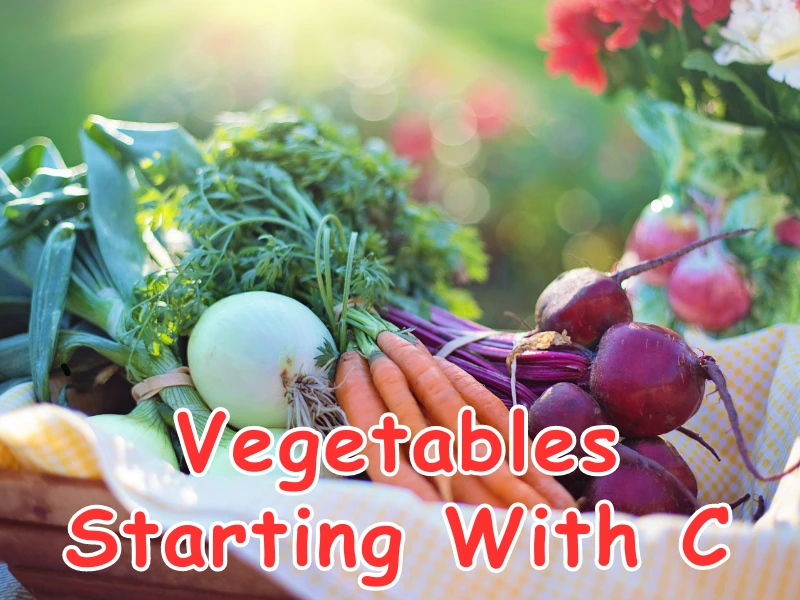
Introduction
Look no further! In this beginner’s guide, we’re going to take you on a journey through a variety of delicious and nutritious vegetables that will surely pique your interest. From classic favorites to unique finds, we’ve got it all covered. So, let’s dive right in and discover the wonderful world of “C” vegetables!
Carrots
Let’s start with a vegetable that needs no introduction – carrots. These vibrant orange root vegetables are not only crunchy and delicious but also packed with nutrients like beta-carotene, which is great for your vision.
Cauliflower
Cauliflower, often referred to as the “white broccoli,” is a versatile vegetable that can be used in countless recipes. From cauliflower rice to cauliflower pizza crust, the possibilities are endless.
Cabbage
Cabbage comes in various types, including green and red. It’s a staple in many dishes, such as coleslaw and sauerkraut, and is known for its impressive nutritional benefits.
Cucumber
Cool and refreshing, cucumbers are a hydrating snack that can be enjoyed on their own or added to salads for an extra crunch. Plus, they’re low in calories, making them a great option for weight-conscious individuals.
Celery
Celery is a crisp and crunchy vegetable that’s often used as a snack or in soups and stews. It’s low in calories and high in fiber, making it a popular choice for those looking to maintain a healthy lifestyle.
Corn
Corn, whether enjoyed on the cob or as kernels, is a classic summer favorite. It’s not only delicious but also a good source of energy due to its carbohydrate content.
Chard
Chard, also known as Swiss chard, boasts colorful stems and dark green leaves. It’s rich in vitamins and minerals, making it a nutritious addition to your diet.
Collard Greens
Collard greens are a type of leafy green vegetable that’s often used in Southern cuisine. They’re packed with nutrients and can be cooked in various ways.
Cilantro
Cilantro, an herb often used in cooking, adds a burst of freshness to dishes. Some people love its distinct flavor, while others find it polarizing due to its unique taste.
Chives
Chives are small, onion-flavored herbs that can be used as a garnish or added to dishes for an extra kick of flavor. They’re easy to grow and can even be cultivated indoors.
Chinese Broccoli
Also known as gai lan, Chinese broccoli is a leafy green vegetable commonly used in Asian cuisine. It has a slightly bitter taste and is often stir-fried or steamed.
Celeriac
Celeriac, or celery root, is a knobby root vegetable with a mild celery flavor. It can be roasted, mashed, or used in soups to add a unique twist to your meals.
Crookneck Squash
This vibrant yellow squash has a curved neck and a slightly sweet flavor. It can be grilled, sautéed, or added to casseroles for a pop of color and taste.
Chayote
Chayote is a green, wrinkled vegetable that is often used in Latin American cuisine. It can be cooked or eaten raw and has a crisp texture similar to that of a cucumber.
Cowpeas
Cowpeas, also known as black-eyed peas, are a type of legume that’s high in protein and fiber. They’re commonly used in Southern and African cuisines.
Chicory
Chicory is a bitter leafy vegetable that can be used in salads or cooked to mellow out its flavor. It’s often used as a coffee substitute due to its roasted roots.
Cardoon
Cardoon is a relative of the artichoke and has a similar flavor profile. It’s often used in Mediterranean dishes and can be enjoyed grilled or braised.
Curly Kale
Kale has gained immense popularity in recent years, and curly kale is one of its varieties. It’s packed with nutrients and can be used in smoothies, salads, or as a crispy snack when baked.
Chinese Cabbage
Also known as Napa cabbage, Chinese cabbage has pale, crinkled leaves and is a staple in Asian cooking. It’s often used in kimchi and stir-fries.
Conclusion:
Exploring the “C” Vegetable Variety In this comprehensive guide, we’ve taken you on a journey through a wide range of vegetables that all have one thing in common – they start with the letter “C.” From the humble carrot to the versatile cauliflower, the options are endless when it comes to incorporating these nutritious and delicious vegetables into your meals. Whether you’re a seasoned chef or a beginner in the kitchen, experimenting with “C” vegetables can lead to exciting and flavorful culinary creations. So, go ahead and embark on your culinary adventure as you explore the world of vegetables starting with “C”!
FAQs
1. Are all carrots orange? No, while orange carrots are the most common, you can also find carrots in various colors like purple, yellow, and white.
2. Can you eat the leaves of cauliflower? Yes, cauliflower leaves are edible and can be used in cooking, similar to other leafy greens.
3. What’s the difference between green and red cabbage? Apart from the color, red cabbage tends to have a slightly peppery flavor compared to the milder taste of green cabbage.
4. Is cucumber mostly water? Yes, cucumber is composed mainly of water, which contributes to its hydrating properties.
5. What part of celery is typically consumed? Both the stalks and leaves of celery are edible and commonly used in various dishes.
6. Can you eat corn raw? Yes, you can eat corn raw, but it’s more commonly cooked before consumption.
7. How do you prepare collard greens? Collard greens can be sautéed, braised, or boiled until tender. They’re often cooked with bacon or other seasonings.

